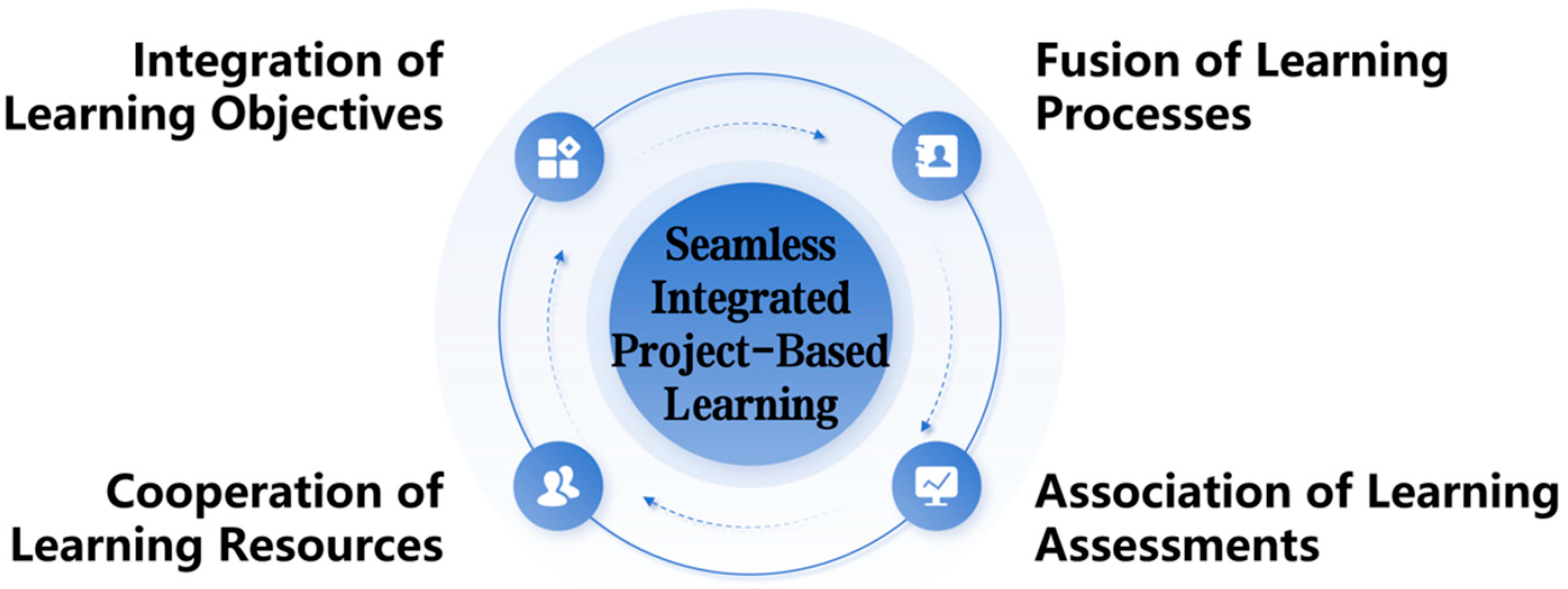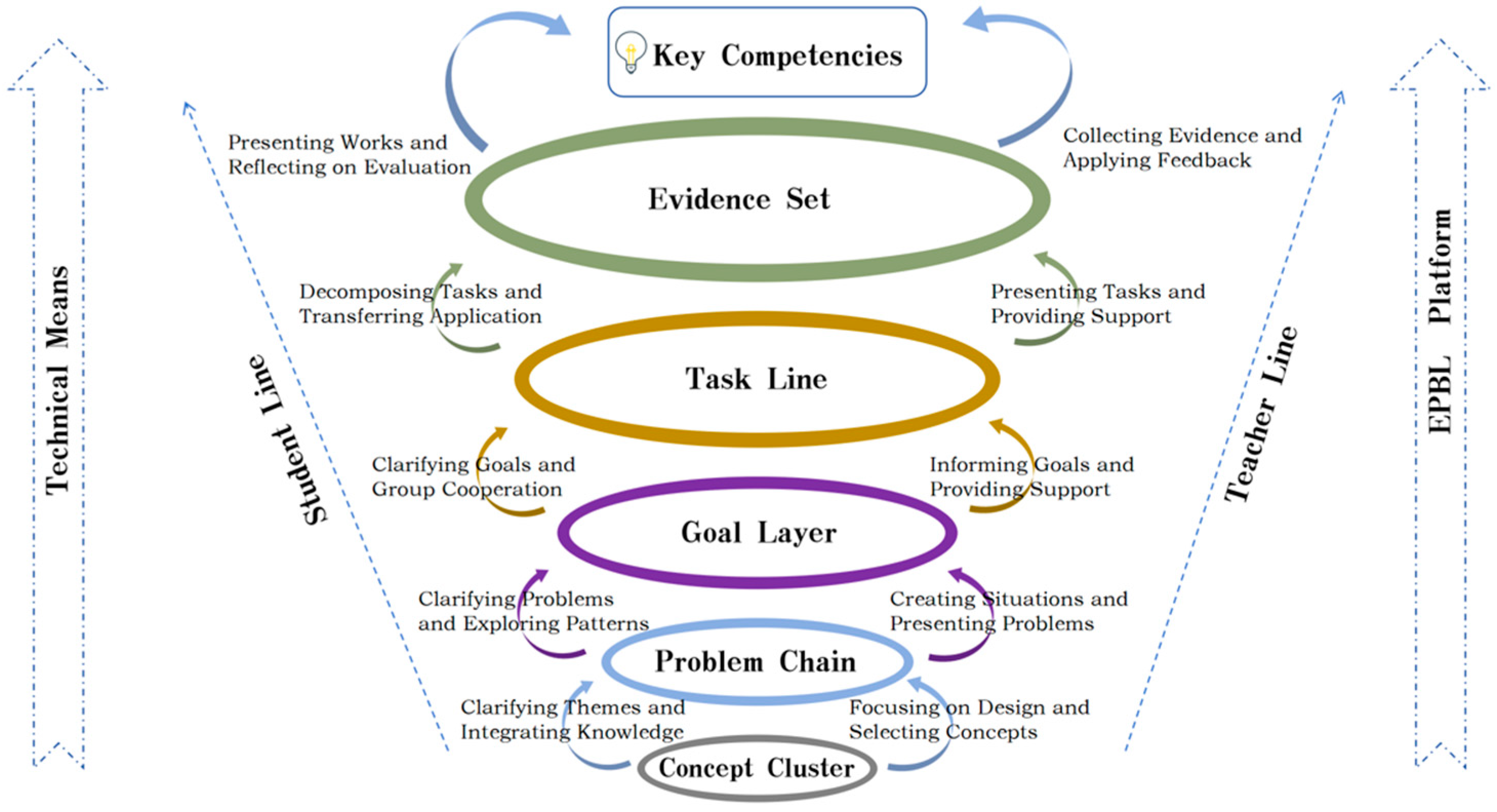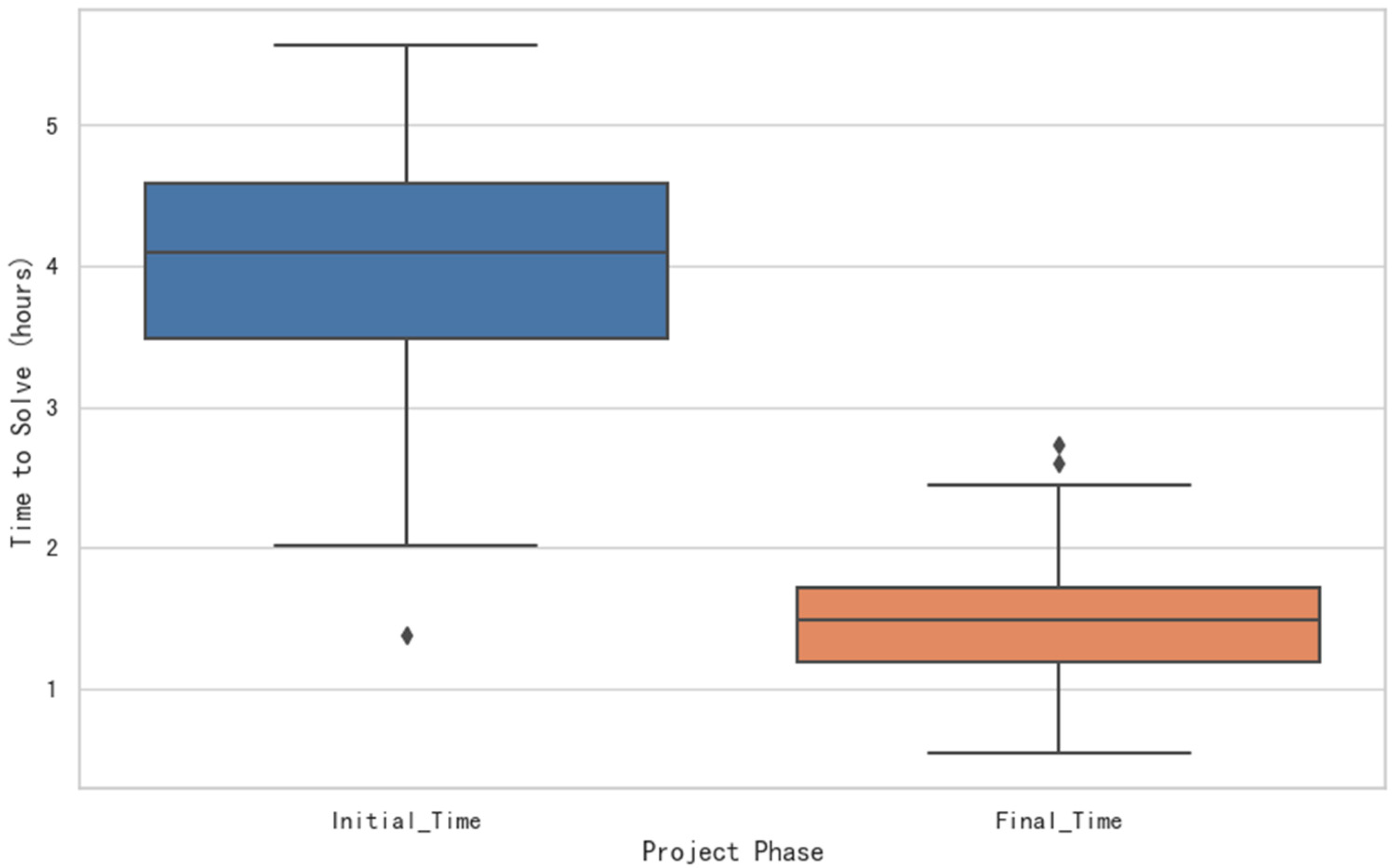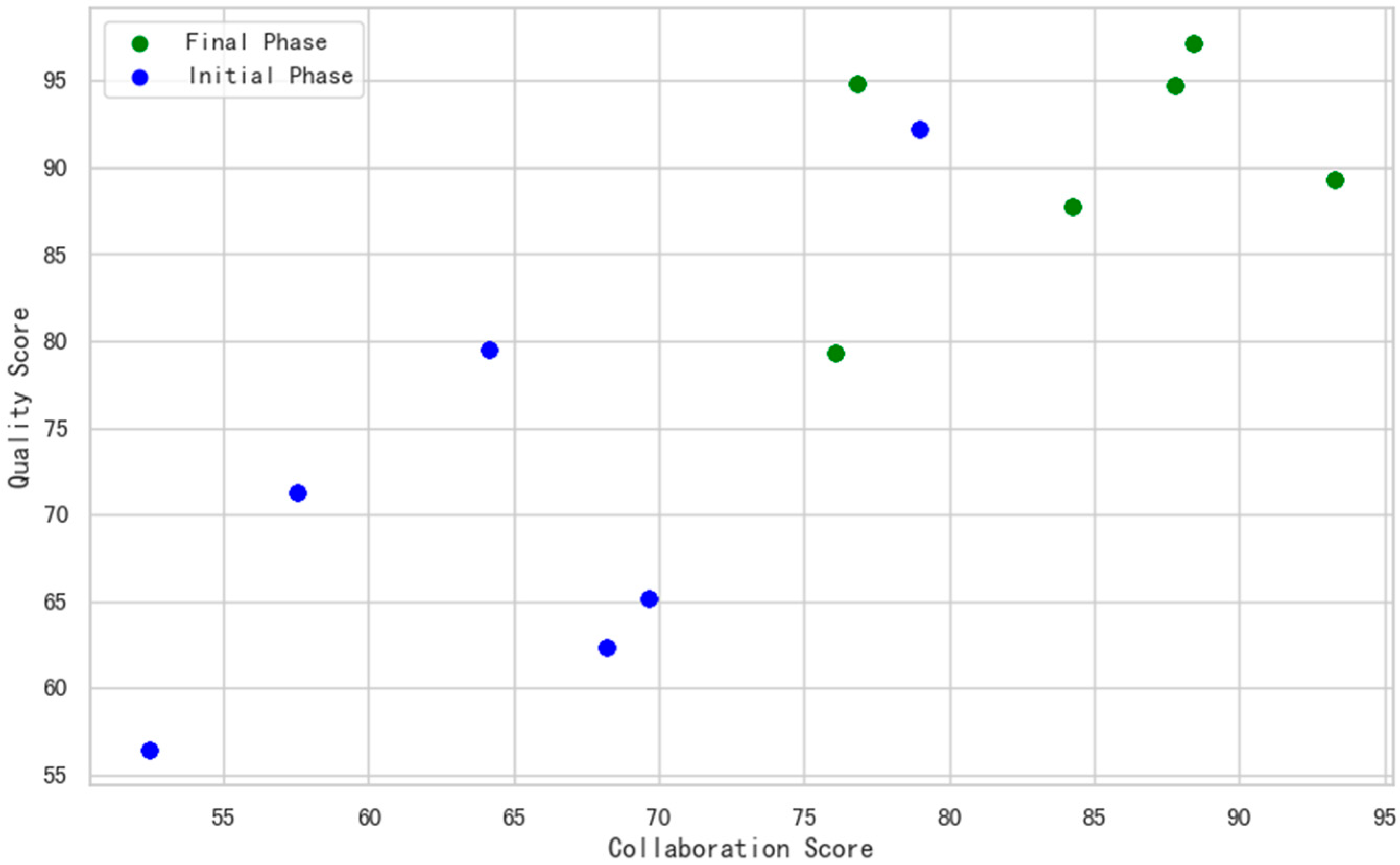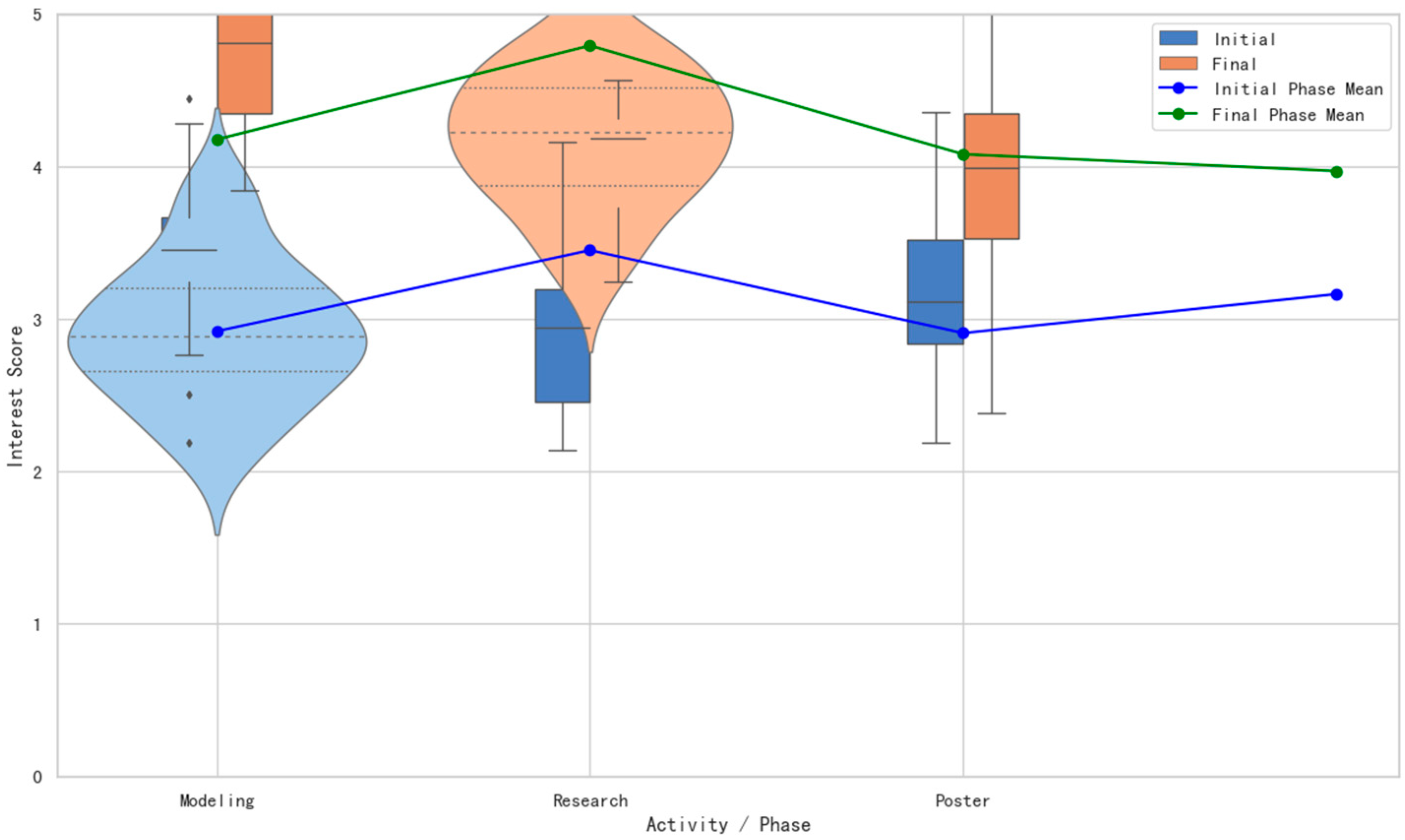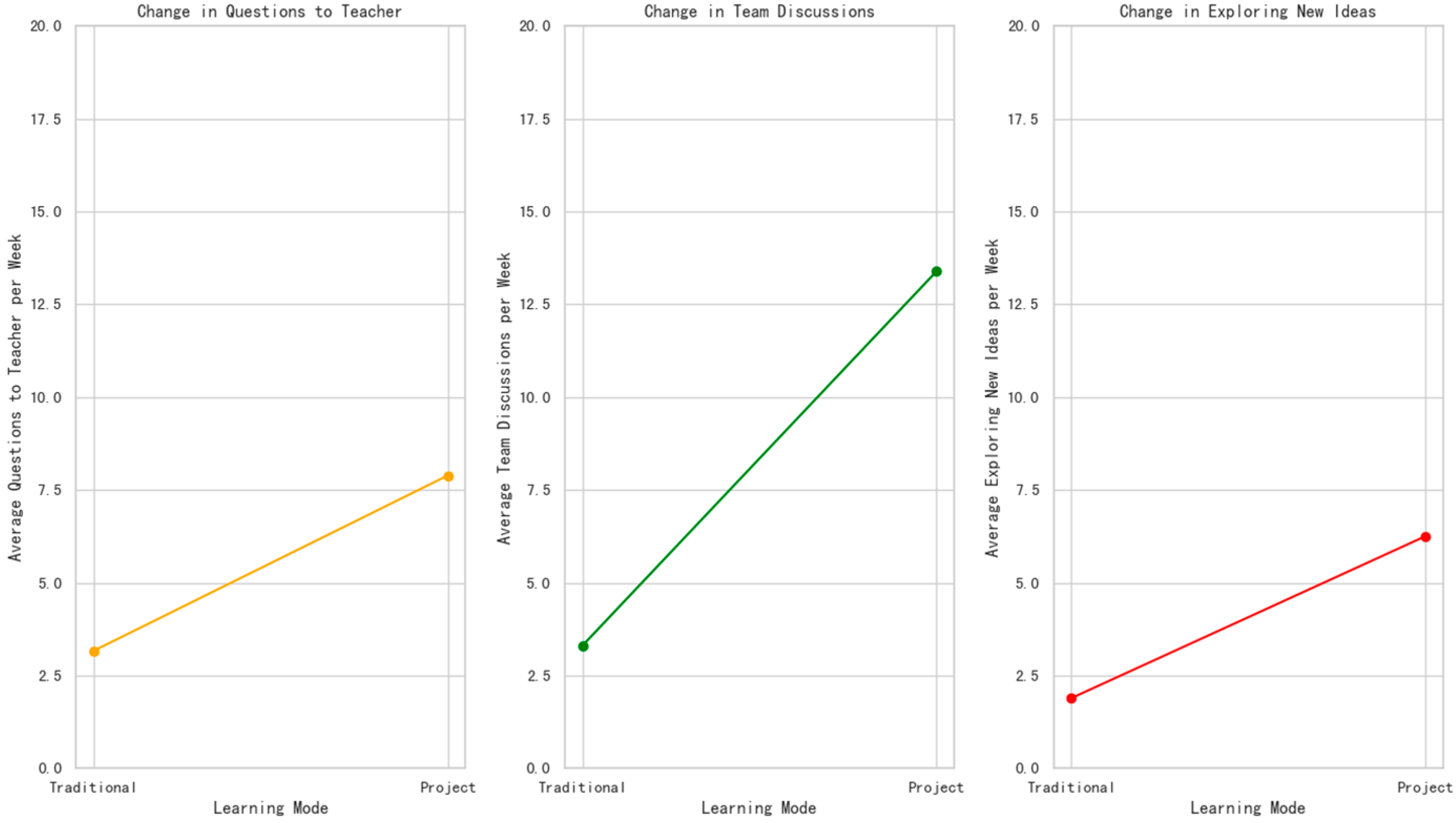3. Key Features of Seamless Integrated Project-Based Learning
Project-based learning, as a method that can stimulate students’ interest and initiative in learning while cultivating their comprehensive abilities, often faces limitations in learning time, space, and modes in practice, which can affect learning outcomes [
13,
19]. Seamless learning provides a new perspective to address this issue. Seamless learning emphasizes continuity and seamlessness in learning, organically integrating formal and informal learning, as well as on-campus and off-campus learning, thereby offering students a richer and more diverse learning experience [
20]. Therefore, the “seamless integrated project-based learning” advocated in this study is a new learning approach that combines project-based learning with the concept of seamless learning, aiming to create a continuous and uninterrupted learning experience for students by integrating various learning resources and environments.
Seamless integrated project-based learning focuses on the organic integration of learning objectives, the deep fusion of the learning process, the collaborative coordination of learning resources, and the effective combination of learning assessment (see
Figure 1). In terms of integrating learning objectives, it is essential to ensure that the knowledge goals of different learning stages and disciplines are interconnected. For instance, Wen, in his research on the Chinese vocabulary learning system, merges family learning with classroom learning objectives to promote students’ comprehensive mastery of vocabulary knowledge [
21]. The integration of the learning process requires breaking the temporal and spatial limitations of traditional learning, achieving smooth connections between formal and informal learning and enabling students to continue learning in diverse contexts. This aligns with the research concepts of Ozdemir and Kalinkara regarding seamless learning in the metaverse environment, where they emphasize that learning should achieve seamless transitions across different scenarios [
22]. The coordination of learning resources means fully integrating various resources, including a wide range of online and offline channels, to provide students with rich and appropriate learning materials. In terms of joint learning assessment, a comprehensive use of multiple assessment methods is necessary to evaluate students’ performance in the project-based learning process, such as knowledge mastery, skill enhancement, teamwork, and other competencies. Through the synergistic effects of these aspects, seamless integrated project-based learning aims to create a coherent, efficient, and effective learning environment for students, promoting a comprehensive improvement in their qualities and holistic development.
In the context of the “Teachers’ Apartments Interior Design” project, the EPBL platform has played a crucial role in facilitating seamless integration of project-based learning. The platform automatically recommended interdisciplinary project cases related to architecture, aesthetics, and economics, which has helped students to better understand the project requirements and promoted the integration of cross-disciplinary knowledge. It also integrated online resources such as virtual laboratories and offline practical activities. Students could access design tools and materials in the virtual laboratory on the platform for simulation experiments and designs and at the same time conduct field investigations and practical operations in real life, achieving a seamless connection between online and offline learning. Moreover, the EPBL platform had the function of real-time data collection and analysis. It recorded students’ learning behaviors, design schemes, and test scores during the project implementation process. Through data analysis, the platform provided personalized feedback and suggestions to students, helping them to adjust their learning strategies in a timely manner and improve learning outcomes. For example, the platform could analyze the innovative points and shortcomings in students’ design schemes and provide targeted suggestions for improvement, promoting continuous progress in the project implementation process. In addition, the EPBL platform supported multi-terminal synchronous collaboration. Students could work on project design and collaboration on different devices such as computers, tablets, and mobile phones. The platform provided real-time collaboration tools like online document editing, design sketch sharing, and discussion zones, making it convenient for students to collaborate at different times and places and realizing the continuity and seamlessness of learning.
3.1. Integration of Learning Objectives
Seamlessly integrated project-based learning incorporates the cultivation of core competencies throughout the entire process of project-based learning, enabling students to not only master knowledge and skills but also to develop critical thinking, innovation capabilities, and a spirit of collaboration [
22]. Personalized learning objectives and content are provided based on students’ interests, abilities, and learning needs, allowing students to fully leverage their strengths and achieve individualized development within project-based learning [
23].
3.2. Integration of Learning Processes
Seamlessly integrated project-based learning organically combines formal and informal learning, allowing students to engage in effective learning across various environments such as classroom learning, extracurricular practices, and community activities [
22]. For example, students can learn theoretical knowledge related to the project in class and then delve deeper into the project’s content through practical activities and online learning outside of class, applying what they have learned to real-life situations. This integration of in-school and out-of-school learning breaks down the boundaries between them, tightly linking school education and social education, enabling students to learn in various settings such as schools, communities, and families [
24]. For instance, schools can collaborate with communities to conduct off-campus practical activities, allowing students to understand and serve society while applying their knowledge in practice, thereby enhancing their practical skills and sense of social responsibility. Learning time is continuous, breaking the limitations of learning time, allowing students to learn at different times and locations [
25]. For example, students can engage in project-based learning during spare time, weekends, and holidays, making full use of fragmented time to improve learning efficiency.
3.3. Coordination of Learning Resources
Seamlessly integrated project-based learning integrates various diverse learning resources, including textbooks, online resources, practice bases, and community resources, providing students with rich learning materials and support. At the same time, a shared learning resource platform is established to promote resource sharing and collaboration among students, teachers, and schools, enabling students to access more learning resources and improve learning outcomes [
26].
3.4. Integration of Learning Assessment
Seamlessly integrated project-based learning adopts a diversified assessment approach, including self-assessment by students, peer assessment, teacher evaluation, and parent evaluation, providing a comprehensive assessment of students’ learning processes and outcomes [
27]. It emphasizes the combination of formative and summative assessments, providing timely feedback on students’ learning situations in formative assessments to help them adjust their learning strategies, while also not neglecting summative assessments, which evaluate students’ project outcomes to assess their learning effectiveness and mastery of knowledge [
28].
“Seamlessly integrated project-based learning” is an innovative learning approach that combines project-based learning with the concept of seamless learning, offering students a richer, more diverse, and continuous learning experience, which helps cultivate their comprehensive abilities and innovative spirit, promoting their overall development [
23].
4. Construction of Seamless Integrated Project-Based Learning Design Model
The design of seamless integrated project-based learning can be approached from two aspects: teacher behaviors and student behaviors. This involves progressively connecting concept clusters, problem chains, goal layers, task chains, and evidence sets, while utilizing technology to facilitate the connections between various learning spaces, ultimately aiming at cultivating core competencies (see
Figure 2).
4.1. Constructing Concept Clusters
Firstly, designers should conduct an in-depth analysis of the theme of the project-based learning they are designing, clarifying its core concepts and key elements. For example, if the theme is “Sustainable Development of Urban Ecosystems”, relevant core concepts might include “ecological balance”, “resource utilization”, and “environmental protection”.
Secondly, they should integrate relevant conceptual systems and establish interdisciplinary integration that transcends the boundaries of different subjects, incorporating concepts from physics, biology, geography, sociology, and so on. For instance, in the “Sustainable Development of Urban Ecosystems”, the concept of energy conversion from physics can be used to understand the efficiency of urban energy utilization, while the ecological cycle concept from biology can be applied to study the material flow in urban ecosystems.
Thirdly, the relevant concepts should be hierarchically constructed. The integrated concepts should be organized into a structured hierarchy to form a conceptual network. This can be constructed from macro to micro, and from abstract to concrete, ensuring that the logical relationships between concepts are clear.
Finally, technological tools should be utilized for support. For instance, mind mapping software such as XMind 8 and MindManager 2020 can visually display the hierarchical structure and connections between concepts. This clear presentation is extremely important for both students and teachers. These pieces of software provide rich editing features, enabling users to add, modify, and move nodes, making the construction of concept clusters more flexible and convenient. Additionally, online knowledge mapping tools like Baidu Brain Map and Notion can be utilized to build more complex and dynamic concept clusters. These tools can visualize the relationships between concepts and support integration with other tools and resources, facilitating further learning and research.
4.2. Organizing Problem Chains
Firstly, designers should propose questions based on the concept clusters. Starting from the constructed concept clusters, they should guide students to formulate questions related to each concept. For example, regarding the concept of “ecological balance”, questions such as “What factors in the city can disrupt ecological balance?” and “How to maintain ecological balance in urban areas?” can be posed.
Secondly, they should determine the levels and progression of the questions. The design of questions should follow the principle of progressing from simple to complex, gradually guiding students to think more deeply. Some foundational questions could be initiated, such as definitions and characteristics of concepts, before gradually transitioning to deeper and more complex questions, such as the relationships between concepts and their application scenarios. It is essential to ensure that there is a progressive relationship among the questions, where the resolution of the previous question provides a foundation for the next question. For instance, while addressing the question “What factors in the city can disrupt ecological balance?”, students may identify “emission of pollutants” as a significant factor, leading them to subsequently ask, “How can the emission of pollutants be effectively controlled?”
Finally, the focus should be on real-life situational problems. Designers should choose specific cases from real life to allow students to experience the practicality of knowledge while solving problems. For example, using a river pollution incident in a certain city as a case study, students may be guided to analyze the causes of pollution, its impacts, and possible solutions. The problems should also have a certain degree of challenge and appeal to spark students’ interest and initiative in learning. Strategies such as creating suspense or introducing hot topics can be employed to capture students’ attention and encourage their active participation in the problem-solving process.
4.3. Linking Goal Layer
First, the overall goals should be clarified. Based on the theme and problem chain of project-based learning, the overall goal of the project can be determined. The overall goal should have clear directionality, encompassing the core content and expected outcomes of the project. For example, the overall goal of the “Sustainable Development of Urban Ecosystems” project could be “to propose a set of sustainable development solutions for urban ecosystems through research and practice, thereby enhancing urban residents’ environmental awareness and ecological literacy”.
Secondly, sub-goals should be decomposed and refined. Based on the learning stages, the overall goal can be broken down into multiple sub-goals, with each sub-goal corresponding to a learning stage or task. For example, in the initial phase of the project, a sub-goal could be set as “understanding the composition and structure of urban ecosystems”; in the mid-phase, a sub-goal could be “analyzing the current status and issues of urban ecosystems”; and in the later phase, a sub-goal could be “proposing sustainable development solutions for urban ecosystems”. Furthermore, associate learning content can be used to ensure that sub-goals are closely related to the learning content and can be achieved through the completion of learning activities and tasks. For instance, to achieve the sub-goal of “analyzing the current status and issues of urban ecosystems”, students need to learn relevant investigation methods, data analysis techniques, etc., and conduct field investigations and data collection.
Lastly, a hierarchical goal structure should be established. A pyramid structure can be used to place the overall goal at the top level, the sub-goals at the middle level, and specific learning tasks and activities at the bottom level. This system can clearly display the hierarchical relationship between goals, making it easier for students to understand and grasp the focus and direction of learning. Additionally, it allows for dynamic adjustments; based on project progress and students’ learning needs, timely adjustments and optimizations to the goal hierarchy can be made to ensure that the goals remain targeted and feasible, effectively guiding the implementation of learning activities.
4.4. Structuring Task Lines
First, tasks should be designed based on goals. Corresponding learning tasks and activities can be designed according to the refined sub-goals. Tasks and activities should have clear goal orientation, helping students to achieve sub-goals and ultimately the overall goal. For example, to achieve the sub-goal of “understanding the composition and structure of urban ecosystems”, the following tasks can be designed: consulting relevant materials to learn about the components of urban ecosystems; visiting urban parks, sewage treatment plants, etc., to observe the operation of urban ecosystems in the field; and creating diagrams of the composition and structure of urban ecosystems.
Secondly, the order and association of tasks should be determined. The execution order of tasks can be arranged in a logical sequence to ensure continuity and progression between tasks. For example, when learning the concept of “energy conversion”, students could first learn about the types and characteristics of different energy sources, then study the principles and methods of energy conversion, and finally conduct experiments on energy conversion to deepen their understanding of the concept. Tasks should be interrelated and support each other, forming an organic whole. For instance, in the “Sustainable Development of Urban Ecosystems” project, there is a close relationship between the tasks of “investigating urban pollution sources” and “analyzing the impact of pollution sources on ecosystems”; completing the former task can provide data and information support for the latter.
Lastly, diverse types of tasks should be introduced. Exploratory tasks such as experimental investigations, field surveys, and literature studies can be designed to cultivate students’ inquiry abilities and innovative spirit. For example, students could conduct water quality testing experiments to investigate the water quality conditions of urban rivers, or students could perform field surveys on urban waste management to understand the current situation and issues of waste disposal.
Cooperative tasks such as group discussions and project collaborations should be arranged to cultivate students’ teamwork and communication skills. For example, students could work in groups to collaboratively create a model of the urban ecosystem, or they may engage in collaborative projects on urban sustainable development to collectively propose solutions. Alternatively, creative tasks may be set up, such as creative design and artwork creation, to foster students’ creativity and imagination. For instance, students could design a planning scheme for an urban ecological park or create a poster about urban ecological protection.
4.5. Clarifying Evidence Sets
First, the types of evidence should be determined. Based on the goals and tasks of project-based learning, one must identify the types of evidence that need to be collected and analyzed. Evidence types can include data, facts, cases, images, videos, etc. For example, in the “Sustainable Development of Urban Ecosystems” project, it may be necessary to collect data on urban energy consumption, environmental quality data, and survey data on residents’ environmental awareness.
Secondly, evidence collection methods should be designed. Observation methods may include collecting firsthand data by observing and recording natural phenomena, social phenomena, etc. For example, changes in the water quality of urban rivers and the ecological conditions of urban parks can be observed. Survey methods may include collecting public opinions and views through questionnaires, interviews, etc. For example, surveys on urban residents’ environmental awareness may be conducted to understand their attitudes and behaviors towards urban ecological protection. Experimental methods include designing and conducting experiments to verify hypotheses and conclusions. For example, experiments on energy conversion may be carried out to explore the efficiency and environmental friendliness of different energy conversion methods. Literature research methods involve referring to the existing literature and materials to obtain relevant information and knowledge. For example, policies and regulations on urban ecological protection and research reports from both domestic and international sources can be reviewed.
Lastly, an evidence management system should be establish. Electronic spreadsheets and software such as Excel should be used to organize and categorize the collected evidence. Classification can be based on evidence type, collection time, source, etc., to facilitate subsequent analysis and use. Online knowledge management tools, such as Notion, Confluence, etc., should be used to create a shared evidence repository. Students and teachers can upload, share, and manage evidence within this knowledge base, achieving resource co-construction and sharing. Data analysis software, such as SPSS 26.0, R4.4.2, etc., should be used to analyze and process large amounts of collected data, extracting information and patterns from the data. Through data analysis, one can provide a basis for decision-making and improvements in the project.
5. Empirical Analysis of Seamless Integrated Project-Based Learning
Based on the design model of seamless integrated project-based learning, we took the students’ experiences after a campus visit as an opportunity, in conjunction with the ongoing teachers’ apartment renovation project at the school. We initiated a proposal for all third-grade students around the theme of “Interior Space Design of Teachers’ Apartments”, which is closely related to student life and has a certain design aesthetic. Given the background of a relatively high number of young teachers and limited space in the teachers’ apartments, while also needing to meet the housing needs of these young teachers, we asked the following question: As excellent small space designers, how can we design a teacher’s apartment that meets the housing needs of young teachers living on campus while also considering smart and eco-friendly features within a limited budget?
The project lasted a total of 40 class hours (1 h/class). It integrated the concepts of project-based learning and seamless learning, provoking thought through real-life selected scenarios, and was driven by challenging guiding questions to engage students’ higher-order thinking. Through knowledge construction and practical operations, students achieved deep learning, applying knowledge to solve problems. The process was guided by “resource integration”, including resource acquisition, selection, combination, and optimization, with a clear focus on interdisciplinary concepts. This empirical study delved into the practical application and efficacy of a seamlessly integrated project-based learning model. This study employed a quasi-experimental design, leveraging pre- and post-test comparisons to appraise the influence of this EPBL approach on students’ capacity to apply interdisciplinary knowledge, foster core competencies, and engage in the learning process.
This research involved 75 third-grade students, aged between 8 and 9 years, from an elementary school. The project extended over a duration of 40 instructional hours. Cluster sampling was employed to ensure the full participation of all students within the grade level. The participants exhibited foundational subject knowledge and fundamental learning skills requisite for engaging in PBL activities.
A diverse array of data collection methods were utilized, encompassing
Interdisciplinary knowledge tests to ascertain pre- and post-project proficiency;
Evaluations of student design proposals based on quality rubrics;
Learning engagement surveys to gauge student motivation and involvement;
Focus group discussions to glean in-depth insights into student experiences and perceptions;
Teacher observations to document student performance and engagement throughout the project.
In the “Teachers’ Apartments Interior Design” project, a total of 75 students participated in the pre- and post-project assessments. The mean total score before the project was 57.48 with a standard deviation of 4.12, and the mean total score after the project was 84.11 with a standard deviation of 5.22. The mean score improvement was 26.63 with a standard deviation of 6.31. These descriptive statistics provide a clear indication of the central tendency and dispersion of the scores, highlighting the significant improvement in students’ performance. Specifically, for the four evaluation criteria, the mean scores and standard deviations were as follows: space utilization had a pre-project mean score of 17.00 (SD = 2.12) and a post-project mean score of 24.12 (SD = 2.31); functional zoning rationality had a pre-project mean score of 16.00 (SD = 2.01) and a post-project mean score of 22.46 (SD = 2.23); budget planning accuracy had a pre-project mean score of 10.87 (SD = 1.23) and a post-project mean score of 13.79 (SD = 1.45); and creativity and uniqueness had a pre-project mean score of 12.51 (SD = 1.54) and a post-project mean score of 14.44 (SD = 1.67). These statistics not only demonstrate the substantial progress made by the students in all aspects but also enhance the scientific quality and credibility of the study.
5.1. Breakthroughs in Interdisciplinary Knowledge Application
This project serves as a model of seamless integrated project-based learning, achieving remarkable results in academic performance improvement. In the interdisciplinary knowledge application tests, its unique advantages were fully demonstrated. The teacher’s apartment design project seamlessly integrated knowledge from multiple disciplines such as space design, cost accounting, and color matching through technical means, thus breaking traditional disciplinary boundaries. This enabled students to naturally and smoothly apply interdisciplinary knowledge to solve practical problems in real-life situations, significantly enhancing their ability to integrate and apply interdisciplinary knowledge. In the evaluation phase of the design proposal quality, a scientifically rigorous and comprehensive scoring standard was applied, with space utilization, rationality of functional zoning, accuracy of budget planning, and uniqueness of creativity accounting for 30%, 30%, 20%, and 20%, respectively. The average score of the students’ design proposals before the project was 55, which significantly increased to 80 after the project, representing an increase of approximately 45.5% (as shown in
Figure 3). This clearly indicates that students’ mastery and application of relevant knowledge in a seamless learning environment had reached a higher standard, effectively achieving deep integration and efficient application of knowledge, thereby boosting academic performance. Students accessed design templates, budgeting tools and intelligent assessment modules through the EPBL platform, enabling seamless learning across scenarios.
5.2. Comprehensive Enhancement of Core Competencies and Significant Collaborative Development Outcomes
Throughout the project, students’ abilities to solve various problems were exercised and significantly improved (as shown in
Figure 4). For instance, in resolving spatial layout conflicts, only 30% of groups were able to adequately handle such issues within a week at the beginning of the project, while this proportion rapidly increased to 80% by the end of the project. Regarding budget overruns, only 20% of students could propose effective adjustment strategies initially, which rose to 60% later. In terms of problem-solving efficiency, the average time students needed to handle simple spatial layout adjustments decreased from 4 h at the project’s outset to 1.5 h later, clearly reflecting a significant enhancement of students’ abilities to analyze problems, devise solutions, and execute efficiently in complex situations.
As shown in
Figure 5, detailed analysis of team evaluation data revealed that in terms of task allocation rationality, only 40% of teams could clearly define responsibilities and maintain balanced division of labor at the beginning of the project, while this proportion surged to 85% by the end. In terms of communication smoothness among members, about 50% of teams faced varying degrees of communication barriers initially, which decreased to 20% later. Regarding the efficiency of collaborative problem-solving, the average time teams took to resolve problems reduced from 6 h at the project’s outset to 3 h later. Further correlation analysis indicated a strong positive correlation between team collaboration assessment scores, which improved from an average of 60 points (out of 100) at the beginning to 85 points later, and project outcome quality scores, which rose from 65 points to 90 points, demonstrating the crucial role of team collaboration in the successful implementation of the project (correlation coefficient r = 0.8).
We observed stimulation of innovation ability; in terms of quantifying innovative outcomes, there was a significant increase in the number of innovative points proposed by students during the design process. For example, in terms of smart and eco-friendly design elements, each design had an average of only 2–3 innovative applications before the project, which increased to an average of 6–8 after the project. Regarding the deepening and adoption of innovative ideas, only 30% of innovative suggestions were incorporated into the final proposal at the beginning of the project, while this proportion grew to 65% by the end, fully demonstrating the increasing activity of students’ innovative thinking and the continuous enhancement of their innovation capabilities.
5.3. Igniting Learning Enthusiasm and Fully Stimulating Inner Motivation
We observed significant enhancement of interest in learning; a comparison of the results from the learning interest survey revealed that project-based learning had a highly positive impact on students’ learning interest (as shown in
Figure 6). Prior to the project, the average interest rating of students regarding design-related project learning methods and relevant subject knowledge was 3 points (out of 5), whereas after the project, this average rating increased to 4.2 points, representing a growth rate of 40%. Further analysis of the feedback on interest at different stages of the project shows that students’ interest rating for the model-making stage rose from 3.5 points to 4.8 points, for the user research stage from 2.8 points to 4 points, and for the poster design stage from 3.2 points to 4 points. Interest in each stage significantly improved, indicating that project-based learning comprehensively stimulated students’ learning interest, leading them to engage more actively and proactively in the learning process.
We saw a dramatic increase in learning initiative; in terms of time invested in learning, the average time students spent on each stage of the project significantly increased compared to traditional classroom learning (as shown in
Figure 7). In traditional classroom settings, students typically invested an average of 2 h per day, whereas during the project implementation, this number rose to 4.5 h, reflecting a 125% increase. In terms of the frequency of proactive learning behaviors, the number of times students actively consulted teachers with questions increased from an average of 3 times per week to 8 times, the frequency of spontaneous discussions organized among team members rose from 4 times per week to 12 times, and the instances of self-exploration of new design ideas grew from 2 times per week to 6 times. These data fully illustrate that students’ proactive engagement in learning was greatly enhanced during the project-based learning process.
6. Conclusions and Discussion
From a macro perspective on educational philosophy, the temporal and spatial constraints of traditional learning, as well as the separation of disciplines, urgently need to be changed. As Chan pointed out, learning should break through traditional boundaries and move towards a more integrated and coherent model [
2], and Klopfer et al. also mentioned that the development of mobile technology provides strong support for the transformation of learning models [
29]. In this context, the deep integration of project-based learning and seamless learning has already become a key aim within educational progress. This requires educators to adeptly explore real-life scenarios and cleverly transform them into learning projects, creating a bridge through which students can apply knowledge in diverse contexts, achieving smooth transference and deep internalization of knowledge from theory to practice. This view aligns with the idea emphasized by Looi et al. about utilizing technology to achieve sustainable seamless learning to promote knowledge application [
23]. At the same time, Csikszentmihalyi’s theory of flow suggests that this integrated learning model can better stimulate students’ intrinsic motivation to learn, allowing them to reach a state of immersion during the learning process, thereby enhancing the effectiveness of learning [
30].
Focusing on the specific operational aspects of teaching practice, teachers bear the responsibility of constructing a systematic and rigorous learning framework. They need to accurately distill core concepts from a complex body of knowledge and then design progressively layered and clearly defined learning tasks according to logical connections, establishing a scientific and effective evidence collection and analysis system. Taking the “Teachers’ Apartments Design” project as an example, through careful guidance, teachers encouraged students to successfully integrate multidisciplinary knowledge, achieving a comprehensive understanding of knowledge and enhancing their abilities while solving real-world problems, fully demonstrating the key role of systematic instructional design in promoting deep learning and ability development. This underscores the critical role of teachers in guiding students’ learning processes, as mentioned by Rogers and Price, as well as the significance of systematic instructional design in facilitating deep learning [
31].
Focusing on the core goal of student development, this learning model undoubtedly provides strong practical support, indicating its remarkable effectiveness in enhancing students’ core competencies. Numerous studies have confirmed this, such as the research by Hmelo-Silver et al. on the impact of problem-based learning on students’ abilities, which found that students showed significant improvement in problem-solving skills after participating in similar learning models, being able to more keenly perceive the essence of problems and efficiently devise solutions in complex situations [
32]. Whether it is the ability to sensitively identify the essence of problems in complex contexts and efficiently devise solutions, the ability to complement each other and collaborate effectively in team cooperation, or the ability to break through traditional thinking limitations and generate novel and unique ideas, all have achieved qualitative leaps under the promotion of this learning model. As Sawyer pointed out, this integrated learning model breaks down the traditional barriers of disciplines and learning contexts, providing students with abundant opportunities for thinking collisions, which helps to overcome traditional thinking limitations and foster innovative and unique ideas [
33]. The model’s role in stimulating students’ enthusiasm for learning should not be underestimated; this further alerts educators to place high importance on the careful shaping of learning experiences during teaching, fully creating a proactive and vibrant learning atmosphere, thereby steadily guiding educational reform towards comprehensiveness, practicality, and innovation in order to meet the diverse needs and high standards of talent cultivation in the contemporary era.
In conclusion, this study demonstrated the effectiveness of seamlessly integrated project-based learning in enhancing students’ academic performance, learning motivation, and problem-solving abilities. However, it is important to acknowledge the limitations of this research. The sample size of this study is limited to third-grade students in a single school, which may limit the universality of the results. Additionally, the project cycle of 40 class hours is relatively short, and the long-term effects of this approach need to be verified in future research. Future studies could further explore the effectiveness of seamlessly integrated project-based learning in different educational stages, subject areas, and cultural backgrounds. Longitudinal studies could also be conducted to investigate the long-term impact of this approach on students’ development. Moreover, the role of teacher training and professional development in the implementation of seamlessly integrated project-based learning could be examined to provide more insights for educational practice. By addressing these research directions, we can gain a more comprehensive understanding of the potential and limitations of seamlessly integrated project-based learning and contribute to the advancement of educational research and practice.
